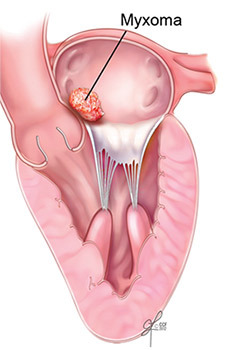What are cardiac tumors?

Cardiac tumors are abnormal growths in the heart or heart valves. There are many types of cardiac tumors. But, cardiac tumors, in general, are rare. The tumors can be cancerous (malignant) or noncancerous (benign). Tumors that begin growing in the heart and stay there are called primary tumors. Tumors that start in another part of the body and move to the heart (metastisize) are called secondary tumors. Most cardiac tumors are benign. But, even benign tumors can cause problems because of their size and location. Sometimes, small pieces of tumor fall into the bloodstream and are carried to distant blood vessels and get in the way of bloodflow to vital organs (embolism).
What causes cardiac tumors?
A small percentage of patients with cardiac tumors have a family history of the condition. Sometimes, the tumors can be part of another health condition, such as NAME Syndrome, LAMB Syndrome or Carney Syndrome. Most often, the tumor develops without any of those conditions or family history. They are the result of cell overgrowth that either starts in the heart or moves to the heart.
What are the types of cardiac tumors?
Primary tumors
Primary tumors affect only 1 in 1,000 to 100,000 people. The most common type of primary cardiac tumor is myxoma. Most of these are benign. Patients of any age can develop a myxoma. They are more common in women than men. Most times, the tumor grows in the left upper chamber of the heart (left atrium) at the atrial septum, which divides the two upper chambers of the heart. Myxomas can grow in other areas of the heart or in the heart valves, but such growth is rare. About 10% of myxomas are hereditary or develop as a result of other diseases (see above).
Other types of benign primary tumors are papillary fibroelastomas, fibromas, rhabdomyomas, hemangiomas, teratomas, lipomas, paragangliomas and pericardial cysts. Malignant primary tumors include pericardial mesothelioma, primary lymphoma and sarcoma.
Secondary tumors
Secondary cardiac tumors are much more common than primary tumors. They do not start in the heart. Instead, they move to the heart after developing in another area of the body. Most often, these tumors start in the lungs, breasts, stomach, kidneys, liver or colon. They can also be tumors related to lymphoma, leukemia or melanoma.
What are the symptoms of cardiac tumors?
Many times, patients do not know they have a cardiac tumor. They are often found when the patient has an echocardiogram for another reason. If the tumor becomes hardened by calcium deposits (calcified), it may be seen on a chest X-ray. Most primary cardiac tumors are discovered when patients are in their 50s and 60s. However, they can be found in younger patients, too.
Patients with cardiac myxoma in the left atrium may develop symptoms. This is due to blocked blood flow through the mitral valve. The blood flow may be blocked all the time, or just when the patient is in a certain physical position (i.e., lying down). While many patients have no symptoms, if blood flow is blocked and there is increased pressure in the left atrium, it can cause shortness of breath, lightheadedness or a cough. The inflammation may cause a fever, and the patient may have joint pain or not feel well.
What are the risks of cardiac tumors?
Tumors that block blood flow can cause heart failure, stroke, atrial fibrillation and blood clots. Another risk is embolism. This means that part of the tumor or a blood clot can travel to other parts of the circulatory system.
How are cardiac tumors diagnosed?
If your doctor thinks you may have a cardiac tumor, the diagnosis can be confirmed using an echocardiogram, Computed Tomography (CT) scan, magnetic resonance imaging (MRI), or radionuclide imaging.
How are cardiac tumors treated?
Because cardiac tumors can lead to problems with blood flow, surgery to remove the tumor is usually the treatment of choice. But, whether surgery is needed depends on the tumor size, whether it causes symptoms, and the patient’s overall health.
Removal requires open heart surgery. But, in many cases, the surgery can be done robotically or using a minimally invasive technique. During the surgery, the surgeon removes the tumor and the tissue around it to reduce the risk of the tumor returning. Because the surgery is complicated and requires a still heart, a heart-lung machine will be used to take over the work of your heart and lungs during surgery.
Recovery after traditional surgery is usually 4 to 5 days in the hospital, and 6 weeks total recovery time. If the tumor is removed using a robotic or minimally invasive approach, your hospital stay will likely be shorter, and you should make a full recovery in about 2 to 3 weeks.
After surgery, you will need to have an echocardiogram every year to make sure that the tumor has not returned and that there are no new growths.